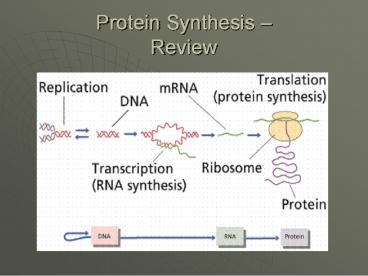Protein Synthesis - PowerPoint PPT Presentation
Title:
Protein Synthesis
Description:
Title: Protein Synthesis - Overview Author: Bemrose Last modified by: Geoff Bemrose Created Date: 9/25/2006 3:21:42 PM Document presentation format – PowerPoint PPT presentation
Number of Views:207
Avg rating:3.0/5.0
Title: Protein Synthesis
1
Protein Synthesis Review
2
Review!!
- http//learn.genetics.utah.edu/content/begin/tour/
3
An Overview
- Genes on chromosomes need to be transcribed into
RNA, and then translated by ribosomes into
protein. - Genes act by directing the production of only ONE
protein each. - This is known as the one gene-one enzyme
hypothesis. - An error in gene sequence can result in a change
in protein sequence, shape, and therefore
function. - TRY THIS Activity p 233, Translating the Code.
4
Overview
- DNA in the nucleus is TRANSCRIBED into a
complementary RNA message that moves to the
cytoplasm. (copied from one medium to another) - Numerous RNA copies can move to different
ribosomes.
5
Overview
- The ribosomes TRANSLATE the message into
Polypeptide chains and process into proteins
(convert into a different language). - Transcription involves the copying of information
in DNA into mRNA - Translation involves ribosomes using mRNA as
blueprint to synthesize a protein composed of
amino acids.
6
A Cool Visual
- http//www.youtube.com/watch?v41_Ne5mS2ls
7
RNA
- ribose sugar with a hydroxyl on 2 Carbon
- uracil replaces the base thymine and pairs with
adenine - single stranded
8
3 Types of RNA
- Messenger RNA (mRNA) varies in length, end
product of transcription of a gene, moves to the
ribosome - Transfer RNA (tRNA) delivers amino acids to the
ribosomes for translation. Shaped like a
cloverleaf very short. - Ribosomal RNA (rRNA) binds with protein to make
ribosomes
9
Step 1 - Transcription
- Within the nucleus, the
- DNA of a particular gene
- unwinds and separates.
- One strand of the DNA is
- transcribed into
- messenger RNA (mRNA)
- in a process called
- transcription.
10
Transcription Making mRNA
11
Transcription divided into three sequential
processes
- Initiation
- RNA polymerase binds to DNA at specific site
known as promoter, near the beginning of the
gene. (usually high of A Tonly 2 bonds to
break!) - Elongation
- Enzyme RNA polymerase puts together the
appropriate ribonucleotides and builds the mRNA
transcript
12
- Termination
- Shortly after RNA polymerase passes the end of a
gene, recognizes signal to stop transcribing - mRNA transcript then is completely released from
the DNA and will exit the nucleus - http//www.youtube.com/watch?vztPkv7wc3yU
13
The Final Touches
- the mRNA must be prepared to leave the nucleus.
A 5 cap is added (for protection), and a poly A
tail is added to the 3 end - The mRNA contains regions of code that do not
make the protein (introns). Introns are removed
by spliceosomes. - Spliceosomes join exons (coding regions)
together. - The mRNA strand leaves the nucleus and binds with
ribosomes in the cytoplasm.
14
- P 249, Q 1-6
15
Step 2 Translation
- Once mRNA enters cytoplasm, it is ready to be
translation - Ribosomes made up of two parts a large subunit
(60s) and a small subunit (40s). Bind to the
mRNA (recognizing the 5 cap) - Must be lined up correctly to the proper reading
frame (reading triplets correctly)
16
tRNA
- tRNA delivers amino acids to the polypeptide
building site (ribosome) - tRNA is a small single stranded nucleic acid,
resembles a cloverleaf - one arm anticodon (sequence of three bases
complementary to mRNA) - 3 end has acceptor site for a particular amino
acid - this recognition by tRNA of mRNA is facilitated
through complimentary base pairing. - every tRNA carries only one specific amino acid
- therefore there must be at least 20 (20-64)
different tRNAs
17
Translation
18
Translation
- The mRNA consists of nucleotides that code for a
specific amino acid. The code is in triplet
called a CODON (3 nucleotides 1 amino acid).
Amino acids are brought into place by a molecule
known as transfer RNA (tRNA). This process is
known as translation. Peptide bonds occur b/w
amino acids.
19
Building the Chain
- First codon recognized is start (AUG-methionine)-
aligns the reading frame - ribosome contains two sites for tRNA an A
(acceptor) site and a P (peptide) site. - tRNA (Met- AUG) enters the P site.
- the rest of the tRNA enter at the A site and form
peptide bonds between the amino acids as the
chain forms.
20
- Ribosome translocates one codon over and
continues the chain until it reaches a stop
codon. (UGA, UAG, UAA) - A release factor protein dismantles the complex,
releasing the polypeptide chain. - Enzymes may cleave the chain at specific places
21
(No Transcript)
22
http//www.youtube.com/user/ndsuvirtualcellp/a/44
B161B3F290FC23/0/5bLEDd-PSTQ
23
(No Transcript)
24
Protein Synthesis
- Once all the triplet codes (Codons) are read and
the amino acids are brought into place, the
completed protein travels through the ER to the
Golgi. - The Golgi modifies the structure and packages it
into a vesicle. - Vesicle moves to the membrane and is released by
exocytosis.






























